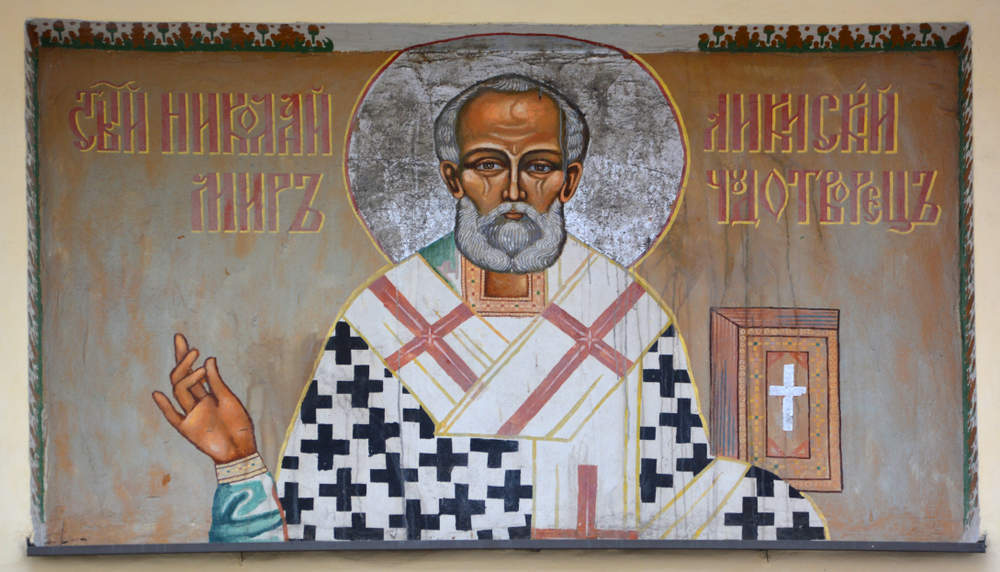
Who was Saint Nicholas? The majority of cultures which celebrate Christmas do so with Father Christmas. The jolly, present-giving fat man in a red suit has become synonymous with the holiday season in many countries. But is Santa Claus real? Well, that depends on how one defines ‘real’.
Certainly there’s no evidence of any man having discovered the secret to self-propelled flight in reindeer populations. Nor is there any evidence that such a man would use this newfound power to deliver gifts around the world on Christmas. In fact, this version of Santa would have to travel at hypersonic speeds to do so. 1,800 miles per second, to be exact, and that’s only if you don’t account for stopping to polish off a few mince pies along the way.
However, the inspiration for our beloved fictionalised version of Santa Claus is real. Saint Nicholas or Nikolaos of Myra was a bishop in Asia Minor (modern day Turkey.) He’s the patron saint of sailors, merchants, archers, repentant thieves, children, brewers, pawnbrokers and students.
The bishop is said to have performed various miracles over the years. He apparently resurrected the dead after a butcher murdered them. He’s also said to have experienced prophetic dreams on his pilgrimage to the Holy Land.
All that said, Saint Nicholas’ most famous ‘miracle’ was his gift-giving. At one stage in his life, Nicholas was asked for help by a poor man. This man could not afford a dowry for his three daughters to get married. As brides’ fathers were supposed to pay for the wedding, this would mean his daughters wouldn’t be able to marry. In the absence of any other employment, this would probably have resulted in them becoming prostitutes. Not on Saint Nicholas’ watch, though!
Jolly old Saint Nic threw three purses filled with gold coins through their window at night time. This ensured the family didn’t have to face the humiliation of being seen accepting charity. It’s also where we get our tradition of Father Christmas giving out presents from.
How well do you really know your competitors?
Access the most comprehensive Company Profiles on the market, powered by GlobalData. Save hours of research. Gain competitive edge.

Thank you!
Your download email will arrive shortly
Not ready to buy yet? Download a free sample
We are confident about the unique quality of our Company Profiles. However, we want you to make the most beneficial decision for your business, so we offer a free sample that you can download by submitting the below form
By GlobalDataWho was Saint Nicholas? What was his real life like?
Of course, even aside from the Santa Claus story, the tales of Saint Nicholas are pretty over-embellished too. Obviously a real human couldn’t have brought the dead back to life or dreamed the future.
However, Nikolaos of Myra was a real life human. Historians estimate that he was alive between 270AD and 343AD. According to Western Christian stories, Saint Nicholas’ remains were transported to Bari, Italy in 1087. These days, the bulk of those bones still lie in the Basilica di San Nicola.
Unfortunately though, the Basilica di San Nicola’s skeleton does not contain the saint’s pelvic bone. However, Professor Tom Higham and Dr Georges Kazan, the Directors of the Oxford Relics Cluster at Keble College’s Advanced Studies Centre, might have found the lost bone this week.
The pelvic bone ended up travelling to America. There it became part of the collection of Father Dennis O’Neill, from Illinois. He originally obtained the bone in France from a fellow collector of religious artifacts.
Using radio-carbon dating, the Oxford scholars found that the bone definitely comes from the right period to belong to Saint Nick. Dr Kazan said:
‘These results encourage us to now turn to the Bari and Venice relics to attempt to show that the bone remains are from the same individual. We can do this using ancient palaeogenomics, or DNA testing. It is exciting to think that these relics, which date from such an ancient time, could in fact be genuine’.
If the bone does come from the same person, it could prove that the stories of Christian mythology about Saint Nicholas are true in parts, implying other parts may also be true. This might allow historians to gain more insight into the history of the real life Santa Claus.







